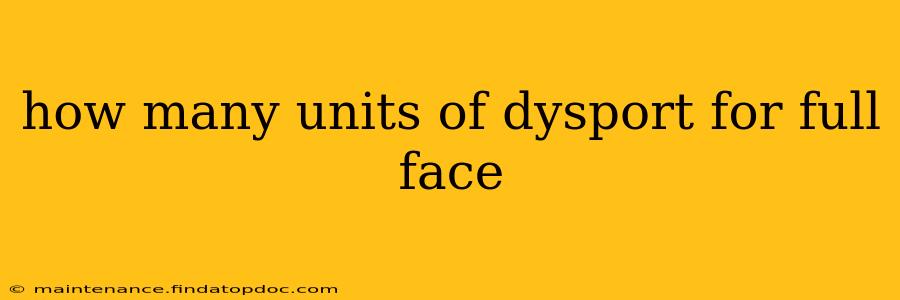How Many Units of Dysport for a Full Face? A Comprehensive Guide
The question of how many Dysport units are needed for a full-face treatment is a common one, and the answer isn't a simple number. Unlike some standardized procedures, the required amount of Dysport varies significantly depending on several individual factors. This guide will explore these factors and provide a clearer understanding of what to expect.
It's crucial to understand that this information is for general knowledge only and should not be interpreted as medical advice. Always consult a qualified and experienced medical professional for personalized treatment recommendations.
Factors Determining Dysport Unit Needs for a Full Face
Several key factors influence the number of Dysport units a practitioner will use for a full-face treatment:
-
Individual Muscle Strength and Anatomy: Everyone's facial musculature is unique. Some individuals have stronger, more active muscles requiring more Dysport to achieve the desired results. Facial anatomy also plays a role; wider faces might necessitate more units than narrower ones.
-
Desired Treatment Areas: A "full face" treatment can encompass different areas. Some patients might only want to target forehead lines, crow's feet, and frown lines (glabella), while others may also include areas like the bunny lines (around the nose), masseter muscles (jawline), or even the chin. The more areas treated, the more units will be needed.
-
Patient's Age and Skin Condition: Younger patients with less pronounced lines might require fewer units than older patients with deeper wrinkles. Skin type and overall skin condition also factor into unit allocation.
-
Desired Level of Correction: Patients' goals greatly influence unit usage. Someone seeking subtle improvements might need fewer units compared to someone aiming for a more dramatic, "frozen" look. This is a crucial discussion to have with your injector.
-
Brand of Neurotoxin and Injector Expertise: While this article focuses on Dysport, it's important to note that different brands of neurotoxins (like Botox) have varying potencies. An experienced injector is adept at accurately assessing individual needs and adjusting unit allocation based on experience and the specific neurotoxin used.
What is the Typical Range?
While there's no magic number, many full-face Dysport treatments utilize between 30 and 60 units, sometimes more. However, this is a broad range, and it's inaccurate to apply it universally. A skilled practitioner will create a customized treatment plan tailored to your specific needs and goals.
How Much Does a Full Face Dysport Treatment Typically Cost?
The cost varies based on the number of units used and the geographical location. It's always best to consult with several practitioners to obtain multiple quotes and understand the pricing structure.
What are the Potential Side Effects of Dysport?
Like any medical procedure, Dysport injections have potential side effects, albeit usually mild and temporary. These can include bruising, swelling, redness, and discomfort at the injection sites. More serious, though rare, side effects might include drooping eyelids or eyebrows (ptosis). A skilled injector will minimize the risk of complications.
How Long Do the Effects of Dysport Last?
The effects of Dysport typically last for 3-4 months, after which the treated muscles gradually regain their function. Maintenance treatments are usually recommended to sustain the results.
Are there alternatives to Dysport for full-face treatment?
Yes, several alternatives exist, such as Botox, Jeuveau, and Xeomin. Each neurotoxin functions similarly but may have slight variations in potency and duration.
In conclusion, determining the precise number of Dysport units for a full-face treatment requires a personalized consultation with a qualified medical professional. Factors such as individual anatomy, desired results, and the practitioner's expertise significantly influence the unit allocation. Open communication with your injector is essential to achieve the best possible outcome.
